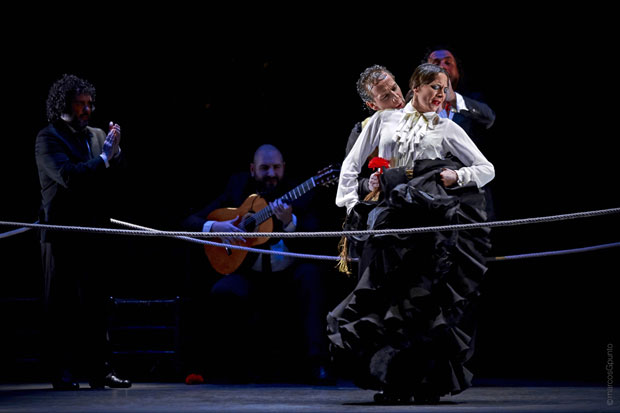
© Marcos G Punto. (Click image for larger version)
Compania Manuel Liñán
Reversible
★★★★★
London, Sadler’s Wells
26 February 2017
Interview with Manuel Liñán
www.manuellinan.com
www.sadlerswells.com
Manuel Liñán’s new show began where his last one left off. Nomada, which closed the Flamenco Festival London, in 2015, had finished with a twist in the tail. The surprise had gradually unfolded with the undulating turns of a dancer in a green, elaborately patterned bata de cola (flamenco dress with a long train) brandishing a mantón (fringed, patterned flamenco shawl) the size of a small carpet. As the dancer slowly turned inwards from facing away from the audience and lights illuminated the different circles being traced by the separately revolving shawl, body and trailing dress, it became apparent that this was Manuel Liñán himself.
Reversible begins with the curtains still down and the sound of footwork (zapateado) coming from the unseen stage beyond. As the fabric barricade rises, there is Liñán, again wearing the bata de cola (although this one is a shiny black number with crimson frills in the train). His opening statement of a buleria, rich in traditional flamenca poses, sets the tone for Reversible as continuing Liñán’s ongoing challenge to the deep-rooted gender stereotypes of flamenco, which he pursues through evoking an image-rich association with the childhood pastimes of skipping and boxing.
The “boxing” episode – a piece called Cantiñas – holds sway as the centrepiece of Reversible. The essence of a ring (why is a boxing ring so-called, when it’s a square?) is created by one thick rope being fixed around the waists of four men, each representing a corner stanchion of the “ring”, before a combative duet is danced within the ropes by Liñán and Lucia Álvarez (La Piñona) with a portly man appearing to officiate as referee. When the dancers disappear at the end of “round one”, this man – the gypsy bailaor El Torombo (Francisco José Suárez Barrera), now 46 years-old – performs his own raw alegrías, shimmering with such powerful energy that it pulls his white shirt from the waistband of his trousers, while his long, curly hair glistens with sweat.
When the combatants return for the second round, they have flipped clothing: Liñán is back as “Manuela”, in the bata, and La Piñona is tightly ensconced in high-waisted black trousers. The dance now seems to be more seductive as Liñán lures Álvarez towards him. What is obvious is that the natural way he curls the trail of the dress with his heel as an integral part of the dance is no less elegant or commanded by expert technique than that of the most skilful bailaora. Liñán is not just a man putting on a dress to simulate the dancing of a woman; he dances as if a highly-trained bailaora, with eloquent arm and wrist movements, flicking the dress from side to side as his feet master the rhythm. His only concession being that the shoes hidden under the dress remain those of a man.
Flamenco Festival – Cía Manuel Liñán from Sadler's Wells on Vimeo.
Rope is Reversible’s leit motif and is used to bind Liñán and Jose Maldonado together in the folkloric “skipping” duet. When both men are rattling out their percussive footwork, at considerable speed, and in unison, it provides an incredible spectacle. Their synchronisation seems intuitively bound together, as if matching the knot of the rope. After the gentle interlude of a tremolo guitar solo by Pino Losada, Liñán returns to perform a Tientos y Tangos, his footwork beating out this slow dance, in double time; finishing phrases abruptly. Each dance number in Reversible concludes dramatically with the dancer/s travelling to end with a flourish under a sharp down spotlight at the front of the stage.
Liñán surrounds himself with great artists, from the expressive singing of David Carpio and Miguel Ortega; the peaceful and expressive toque (guitar playing) of Losada and Francisco Vinuesa to the stylish, disciplined dancing of La Piñona. Liñán, however, is the star and just as with most other shows in this festival (the exception being the opening deconstruction of flamenco by the force of nature that is Israel Galván), Reversible finished with a soleá. Three earlier shows had been closed, respectively, by Eva Yerbabuena, Mercedes Ruiz and Juana Amaya; each a truly great bailaora. But, here, of course, the dancer in the dress is again Liñán; coming full circle back to where Reversible had begun: his arms dancing for themselves, like snakes being charmed from the basket; his feet rattling out a forceful clarity of percussive rhythms; and the unmistakeable angularity of his torso, weaving in and out of the traditional shapes and forms of a flamenca bailaora. His soleá mixed passion with precision, weaving intricate movement to match the soulful expressionism in Carpio’s voice.
Liñán is one of flamenco’s great innovators; driving the art forward through the twenty-first century; but, unlike others in this avant garde, such as Galván and Rocío Molina, Liñán’s creativity is built firmly upon the solid foundation of flamenco tradition. Reversible celebrates the rich flamenco heritage of the Café Cantante period (between the late nineteenth century and the 1920s) when flamenco emerged from the informal settings of street and family to crystallise in public entertainment. It also represents Liñán’s own personal journey from the boy who wanted to skip instead of box; to the man who can dance flamenco with great technique and exceptional flair, both in the traditional male and female forms.
The politics of flamenco are notoriously conservative and the traditionalists don’t like their heritage to be messed with. So, it’s a supreme accolade for Liñán’s talent, as both director and performer, that Reversible, cross-dressing and all, won the Critics’ Choice Award for Best Show at the Festival de Jerez, in flamenco’s heartland of Andalucía. This show is of historic significance; a watershed production that provided a superb ending to this year’s Flamenco Festival London.







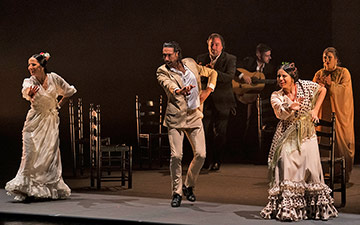


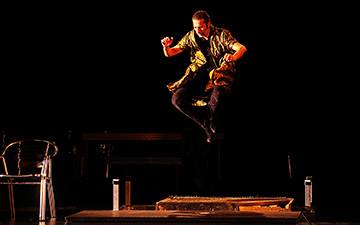


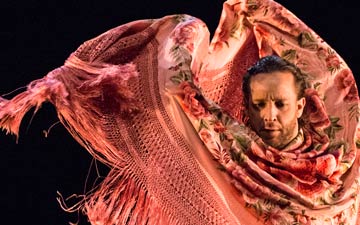
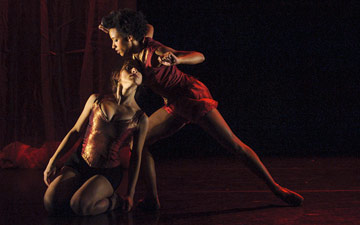


You must be logged in to post a comment.